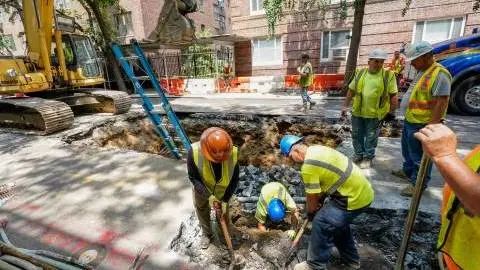US Construction: Residential boom offsets the gloom
The pandemic hit the construction sector hard, but plunging borrowing costs and the prospect of working from home stimulated a subsequent housing boom that has offset weakness in the non-residential sector. Now though, there is growing evidence that the surge in buying is over with a tougher environment facing home builders
A short sharp shock
As the pandemic-induced shutdowns spread across the country last March and April, we saw spending drop 5% across both residential and non-residential construction with employment plunging by 1.1mn in the sector as a whole. This was equivalent to 14.6% of construction workers losing their jobs. With working from home not an option, it was one of the first sectors allowed to return to the workplace and employment swiftly recovered given the robust order backlog. Government and Federal Reserve stimulus quickly stabilised sentiment, but the relative performance of residential and non-residential construction soon markedly diverged.
Nominal construction spending by sector, February 2020 = 100

Residential rallied on mortgage rate plunge
Aggressive interest rate cuts and quantitative easing from the Federal Reserve drove down Treasury yields, which dragged mortgage costs lower, too. With equity markets having swiftly recovered their losses, consumer confidence among those who kept their jobs rebounded and this triggered a wave of interest in home buying.
The economic pain from Covid containment measures was especially acute in leisure, hospitality and retail with these three sectors accounting for half of the more than 22 milion jobs lost between February and April. These sectors tend to be lower paid with employees less likely to be homeowners or potential home buyers. Higher skilled workers and employees who weren't public facing were better able to switch to home working and were much more likely to keep their jobs.
Consequently, mortgage applications for home purchases soared to levels last seen before the Global Financial Crisis with the US property market experiencing a wave of buying, particularly in the suburbs as workers decamped from the major cities.
Mortgage applications for home purchase & borrowing costs

Health concerns and the prospect of a prolonged period away from the office was key, with the purchase of second homes also a major driver of activity. According to online real estate brokerage Redfin, the demand for second homes grew at double the rate of that for primary homes. The relative affordability of property was underscored by the fact in 2Q 2020, mortgage debt service costs fell below 4% of personal disposable income for the first time ever.
Housing inventory for sale
With inventory levels at historically low levels for both existing and new homes, prices soon started to rise and the profitability of new home building increased. This stimulated a huge residential construction boom with building permits, which had slumped from an annualised level of 1.55mn in January 2020 to 1.094mn in April, surging 72% to 1.883mn in January 2021. This is the highest level since 2006 with housing starts performing similarly.
Housing starts and building permits

Residential outlook: Housing demand past the peak
Mortgage applications for home purchases have already slowed markedly despite mortgage rates remaining below 3% for a fixed 30Y mortgage. This clearly suggests waning demand. This softening in activity is partly because of people returning to the big cities as companies call workers back to the office, but also because housing affordability is deteriorating.
Nationally, the S&P Case Shiller house price index is up nearly 19% year-on-year with the median price of a new home pegged at $361,800 and an existing home costing $363,300. This is already reflected in consumer confidence with a marked decline in home buying intentions mirroring the decline in mortgage applications.

On the positive side, employment is rising strongly and we expect it to fully recover to pre-pandemic levels by mid-2022 while there is growing evidence of wage pressures amid labour market shortages. This should keep overall household income growth firm and provide solid foundations for demand, but with demand and supply moving into better balance, price appreciation is likely to moderate.
Homebuilder sentiment on the wane
The latest sentiment reading from the National Association of Home Builders fell to a 13-month low, with potential buyer traffic clearly slowing. Nonetheless, homebuilders remain positive about the outlook, with the expected future sales component unchanged. We are more cautious and believe that housing activity is returning to its pre-Covid trend. With new home sales and mortgage applications clearly having slowed, we feel residential construction will decline, too.
Given our general economic outlook of strong growth and more persistent inflation pressures, we expect the Federal Reserve to soon announce a tapering of its $120bn per month QE asset purchases that are currently split $40bn per month for agency mortgage-backed securities and $80bn for Treasury securities. We also expect to see the Federal Reserve start to raise interest rates from late 2022. A less stimulative monetary policy backdrop combined with elevated government borrowing, we believe, will push the Treasury yield curve higher with the 10Y Treasury yield set to test 2% over the next six to nine months from the current level of 1.3%. This will inevitably push mortgage borrowing costs higher, with mortgage rates set to rise by 70-90bp over the same period, further hurting home buying affordability.
Construction input costs (PPI YoY%)

Home building set to slow
Another issue for homebuilders is rising commodity prices, supply constraints and a lack of workers to fill required roles. This has resulted in significant cost increases for the construction sector and delayed projects while creating uncertainty about the outlook for profits.
Given this squeeze, amid evidence of falling demand, we expect housing starts to decline to a 1.3-1.4mn annualised range by the end of this year, having peaked at 1.725 mn in March. We believe it will remain broadly within that band for the next couple of years, which is a more pessimistic assessment than the latest Bloomberg consensus figures of 1.57mn for 2022 and 1.548mn for 2023.
Download
Download article
8 September 2021
2022 US Construction Outlook: Non-residential set to boom as housing cools This bundle contains {bundle_entries}{/bundle_entries} articlesThis publication has been prepared by ING solely for information purposes irrespective of a particular user's means, financial situation or investment objectives. The information does not constitute investment recommendation, and nor is it investment, legal or tax advice or an offer or solicitation to purchase or sell any financial instrument. Read more

